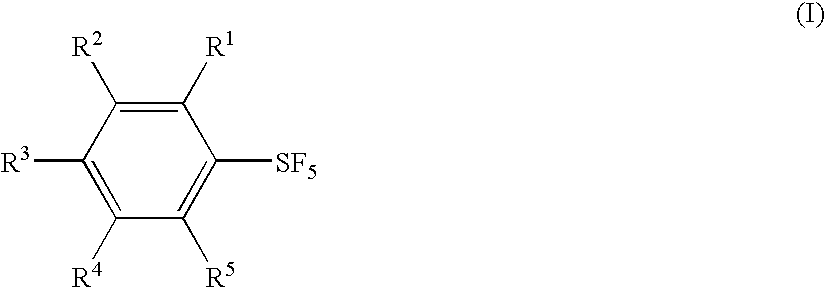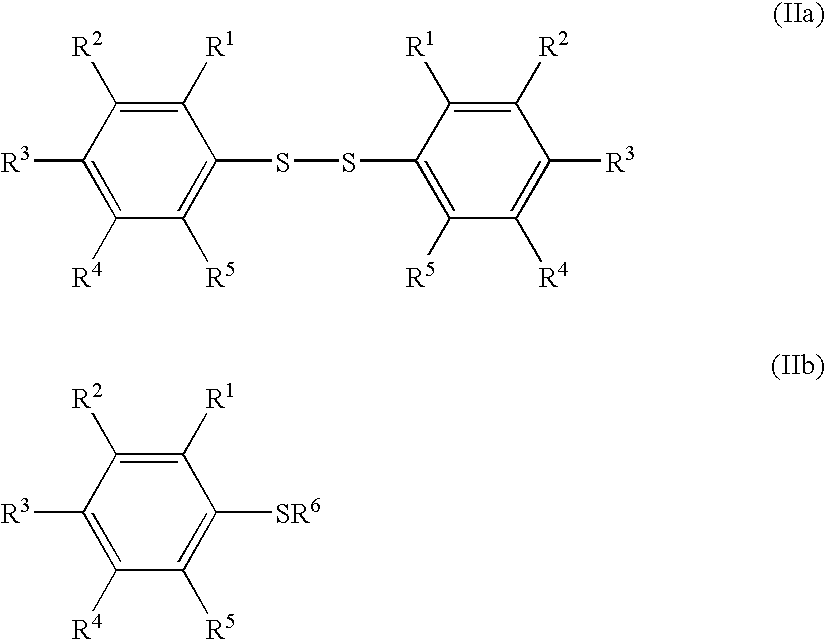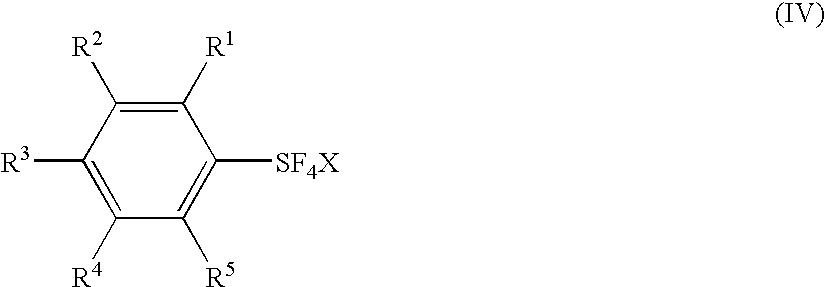Process for producing arylsulfur pentafluorides
a technology of arylsulfur pentafluoride and process, which is applied in the field of preparation of arylsulfur pentafluoride, can solve the problems of difficult, time-consuming, and/or dangerous practice, and achieve the effects of reducing the number of synthesis methods, and improving the quality of arylsulfur pentafluorid
- Summary
- Abstract
- Description
- Claims
- Application Information
AI Technical Summary
Benefits of technology
Problems solved by technology
Method used
Image
Examples
example 1
Synthesis of phenylsulfur pentafluoride from diphenyl disulfide
[0137]
[0138](Process I) A 500 mL round bottom glassware flask was charged with diphenyl disulfide (33.0 g, 0.15 mol), dry KF (140 g, 2.4 mol) and 300 mL of dry CH3CN. The stirred reaction mixture was cooled on an ice / water bath under a flow of N2 (18 mL / min). After N2 was stopped, chlorine (Cl2) was bubbled into a reaction mixture at the rate of about 70 mL / min. The Cl2 bubbling took about 6.5 h. The total amount of Cl2 used was about 1.2 mol. After Cl2 was stopped, the reaction mixture was stirred for additional 3 h. N2 was then bubbled through for 2 hours to remove an excess of Cl2. The reaction mixture was then filtered with 100 mL of dry hexanes in air. About 1 g of dry KF was added to the filtrate. The KF restrains possible decomposition of the product. The filtrate was evaporated under vacuum and the resulting residue was distilled at reduced pressure to give a colorless liquid (58.0 g, 88%) of phenylsulfur chlorot...
examples 2-10
Synthesis of arylsulfur pentafluorides (I) from and sulfur Compounds (IIa)
[0140]
[0141]Substituted arylsulfur pentafluorides (I) were synthesized from the corresponding aryl sulfur compounds (IIa) by the similar procedure as in Example 1. Table 3 shows the synthesis of the substituted arylsulfur pentafluorides. Table 3 also shows the starting materials and other chemicals necessary for the Processes I and II, solvents, reaction conditions, and the results, together with those of Example 1. FC-72 (Fluorinert®) was used as a solvent in Process II in Examples 9 and 10. The Fluorinert® FC-72 was a perfluorinated organic compound having a boiling point of 56° C., which was a product made by 3M Company.
[0142]
TABLE 3Production of Arylsulfur pentafluorides (I) from Aryl sulfur compounds (IIa)Process IEx.(IIa)Halogen(III)SolventConditions(IV)Yield1Cl2 ~1.2 molKF 140 g (2.4 mol)CH3CN 300 mL0~5° C. ~9.5 h88%2Cl2 0.73 molKF 464 g (8 mol)CH3CN 1 L0° C. 10.5 h73%3Cl2 0.28 molKF 36 g (0.63 mol)CH3C...
example 11
Synthesis of phenylsulfur pentafluoride from diphenyl disulfide with a Mixture of hydrogen fluoride and pyridine as a fluoride Source in Process II
[0162]
[0163](Process 1) Phenylsulfur chlorotetrafluoride was prepared in a high yield in the same manner as in Process I in Example 1.
[0164](Process II) A reaction vessel made of fluoropolymer was charged with 341 mg (1.54 mmol) of trans-phenylsulfur chlorotetrafluoride, and 0.5 mL of a mixture of about 70 wt % hydrogen fluoride and about 30 wt % pyridine was added at room temperature. The reaction mixture was stirred at room temperature for 1 hour and heated at 50° C. for 3 hours. After the reaction, the reaction mixture was cooled to room temperature. An analysis of the reaction mixture by 19F—NMR showed that phenylsulfur pentafluoride was produced in 93% yield.
PUM
| Property | Measurement | Unit |
|---|---|---|
| boiling point | aaaaa | aaaaa |
| temperature | aaaaa | aaaaa |
| temperature | aaaaa | aaaaa |
Abstract
Description
Claims
Application Information
 Login to View More
Login to View More - R&D
- Intellectual Property
- Life Sciences
- Materials
- Tech Scout
- Unparalleled Data Quality
- Higher Quality Content
- 60% Fewer Hallucinations
Browse by: Latest US Patents, China's latest patents, Technical Efficacy Thesaurus, Application Domain, Technology Topic, Popular Technical Reports.
© 2025 PatSnap. All rights reserved.Legal|Privacy policy|Modern Slavery Act Transparency Statement|Sitemap|About US| Contact US: help@patsnap.com



